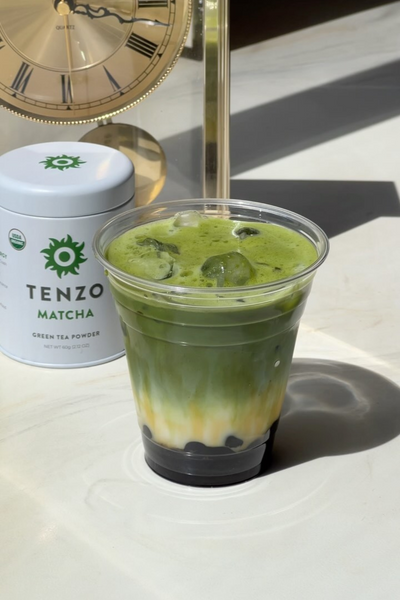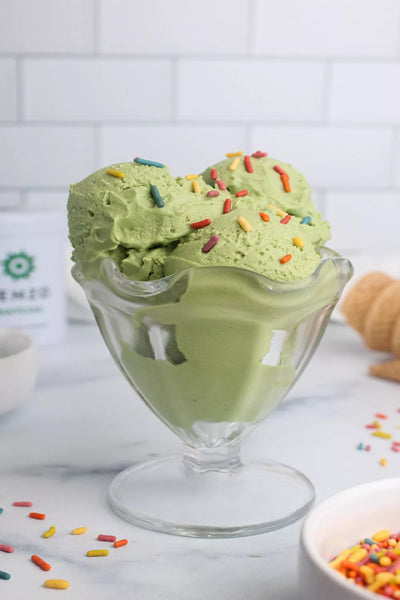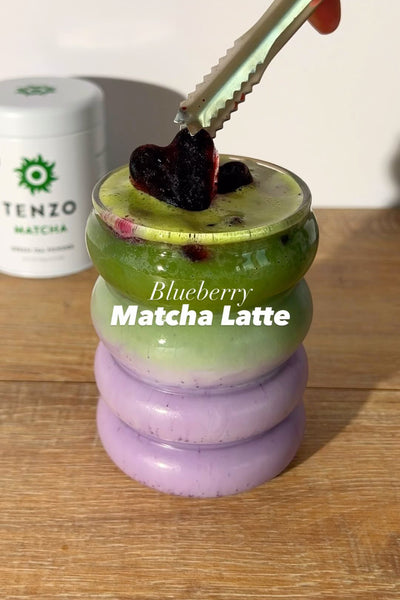Hojicha: What Is It? Comparison to Matcha

If you’re on the search for a coffee substitute or you love learning about tea alternatives, then Tenzo tea is here to help you.
While we’re focused on sharing our tools and resources for matcha tea lovers, we believe that historic, delicious tea options should be available to everyone. That’s why we carry a growing library of guides and information on teas that can provide focus, reduce feelings of stress, and promote long-term health and wellness.
One of those wonderful matcha tea alternatives is hojicha, a unique and versatile type of tea that is reddish or brown in appearance and often served after dinner, the way a cup of coffee might be.
Hojicha has many similarities and many differences from matcha tea, but they are both useful and important in their own way.
Here’s your guide to hojicha, and what sets it apart from your classic matcha drink.
What is Hojicha
If you find yourself reaching for a cup of hojicha during the chilly months of fall, you’re not alone. Hojicha is a type of green tea that is similar to matcha tea in that it is prepared quite differently than traditional teas. Rather than being steamed, the way tea is regularly prepared, hojicha is actually roasted in a porcelain pot.
If you are following the traditional method of preparation, the porcelain pot will be warmed over charcoal at very high temperatures, and it is this process that helps to change the tea from the natural green of the leaves to the reddish, brownish color of the final drink.
There are actually several different types of hojicha to try if you’re searching for warm, toasted flavoring.
Commonly, hojicha is made from bancha, which translates to “common tea”, and is the last tea of the season. This differs from matcha greatly, in that matcha is made from young tea leaves, which helps to preserve the nutrients and antioxidants, as well as the earthy flavoring. But bancha isn’t the only option for hojicha. You may find variations from different parts of the plant, including the twigs, rather than just the leaves.
Matcha at a Glance
While matcha and hojicha have many differences, they are more similar than many other types of tea. Matcha is also a type of green tea, though it has been around significantly longer than hojicha, which was first developed in the 1920s. By contrast, matcha has been used for over one thousand years by many different groups, including monks, Samurai, and more.
Matcha is also prepared in a different way than traditional tea drinks. Rather than being steeped, the young tea leaves are ground into a fine powder and then mixed with hot water.
This allows the tea to maintain more of its health and wellness benefits from the tea leaves’ antioxidants and nutrients, and gives it that overall fresh, earthy flavoring.
Unlike hojicha, which was first developed in Japan, matcha was made in China originally, before being brought into Japan, where the rich, fertile climate allowed it to grow plentifully.
Matcha has many health benefits, both for the physical and emotional overall wellness, and can be used to reduce feelings of stress, promote healthy blood flow, and support the immune system. Most notably, matcha is known for providing a long-lasting, low impact energy boost without the side effects of caffeine crashes, headaches, or jitters.
Hojicha and Matcha: Similarities and Differences
Understanding the similarities and differences between hojicha and matcha can make it easier for you to determine which type of tea is best for your overall health and wellness needs. Here are a few things to consider when deciding between hojicha and matcha.
How is it Prepared?
Matcha and hojicha are both types of green tea prepared differently than traditional tea, but the similarities in preparation end there.
When you make matcha, you will be using the ground powder of green tea leaves that have been harvested very young. It mixes well into hot water and can be used for many different recipes beyond a simple cup of tea, like smoothies, ice cream, brownies, and lattes.
Hojicha, by comparison, is made with tea leaves that are harvested toward the end of the season and can even be made from the twigs of the tea plant. Traditionally, it is steeped in a porcelain pot over very high heat, though you can make it with powder if you are just getting started.
Hojicha requires very high heat, around 90 degrees Celsius or 195 degrees Fahrenheit. It is this hotter temperature that helps to give it that classic toasted, woodsy flavoring and scent. By comparison, matcha should be steeped at about 80 degrees Celsius or 175 degrees Fahrenheit, because the tea leaves are younger and more susceptible to burning.
Health Benefits
Matcha and hojicha are both prepared from green tea plants, and while the preparation process will vary between the two, they maintain many of the same health and wellness benefits.
To start, both types of tea can be useful for reducing feelings of stress and overwhelm and may be recommended for those dealing with emotional health issues. They can both be used to boost the body’s immune system, relieve feelings of tension.
Caffeine Content
Both matcha and hojicha are beneficial to those who are sensitive to caffeine but for slightly different reasons. Matcha has a much lower impact type of energy than drinks like coffee.
It lasts longer and won’t come with the same lasting side effects like caffeine crashes, jitters, headaches, and stress. The caffeine in matcha is gentle enough that matcha is even recommended before bed.
Hojicha is actually nearly caffeine-free, which is a result of the way it is prepared via roasting. The roasting process doesn’t simply remove most of the caffeine content, but it will actually take out much of the bitterness associated with steeped tea.
Even though hojicha doesn’t have caffeine, it is still rich in flavors and nutrients that can give you a sense of alertness and focus and make it easier to stay motivated and energetic throughout the course of the day.
If you do struggle to fall asleep at night and you’re on the search for a cozy and delicious treat that can help you to feel relaxed, hojicha can be an excellent option for your needs.
Taste
The taste you get when you make your next cup of matcha or hojicha is going to vary, depending on where you get your leaves from, what time of the season it is, and even how hot your water is when preparing your drink.
That said, there are a few different types of hojicha with distinct flavors, as they are made out of different parts of the tea plant, whereas matcha is produced only from the tea leaves, themselves.
Overall, matcha is going to produce a rich and earthy taste, which may have hints of freshness or floral to it. This flavoring and richness are why matcha is such an excellent option for many different recipes and why it is often made in thick or sweet recipes like brownies, smoothies, and puddings.
Hojicha has a roasted, toasty flavoring from the roasting process. But don’t let the roasting fool you. When you drink hojicha, you’ll enjoy a gentle, subtle flavoring that can pair well with either sweet or savory dishes and desserts.
Conclusion
When it comes to coffee substitutes that have lots of benefits to your overall physical and emotional health and wellness, you have a few great options. The good thing is, you can mix and match your hojicha and matcha drinks at different times of the day or in different recipes to get the full effects of each, like boosted immunity, improved long-term heart health, oral hygiene support, and more.
Matcha is designed to provide long-lasting, low-impact energy that can keep you focused and engaged throughout the day without any of the lasting side effects of coffee like crashes, jitters, or headaches. Hojicha doesn’t have a caffeine content because it is roasted, but it’s still rich in nutrients that will keep you energized and engaged.
With matcha, you’ll enjoy earthy, sweet flavoring, and with hojicha a roasted, almost caramel taste that’s perfect for cozy nights.
No matter what kind of tea you want to prepare next, Tenzo Tea is here to help. We believe that healthy, delicious teas should be available to everyone to make from the comfort of their homes and it’s easy to get started with the tools and resources available here at Tenzo Tea. Check out our growing catalog of recipes and find your favorites today.
Sources:
Edo Period Japanese Porcelain | Met Museum
How to Grow Tea Plant | The Spruce
Caffeine: How Much is Too Much | Mayo Clinic










